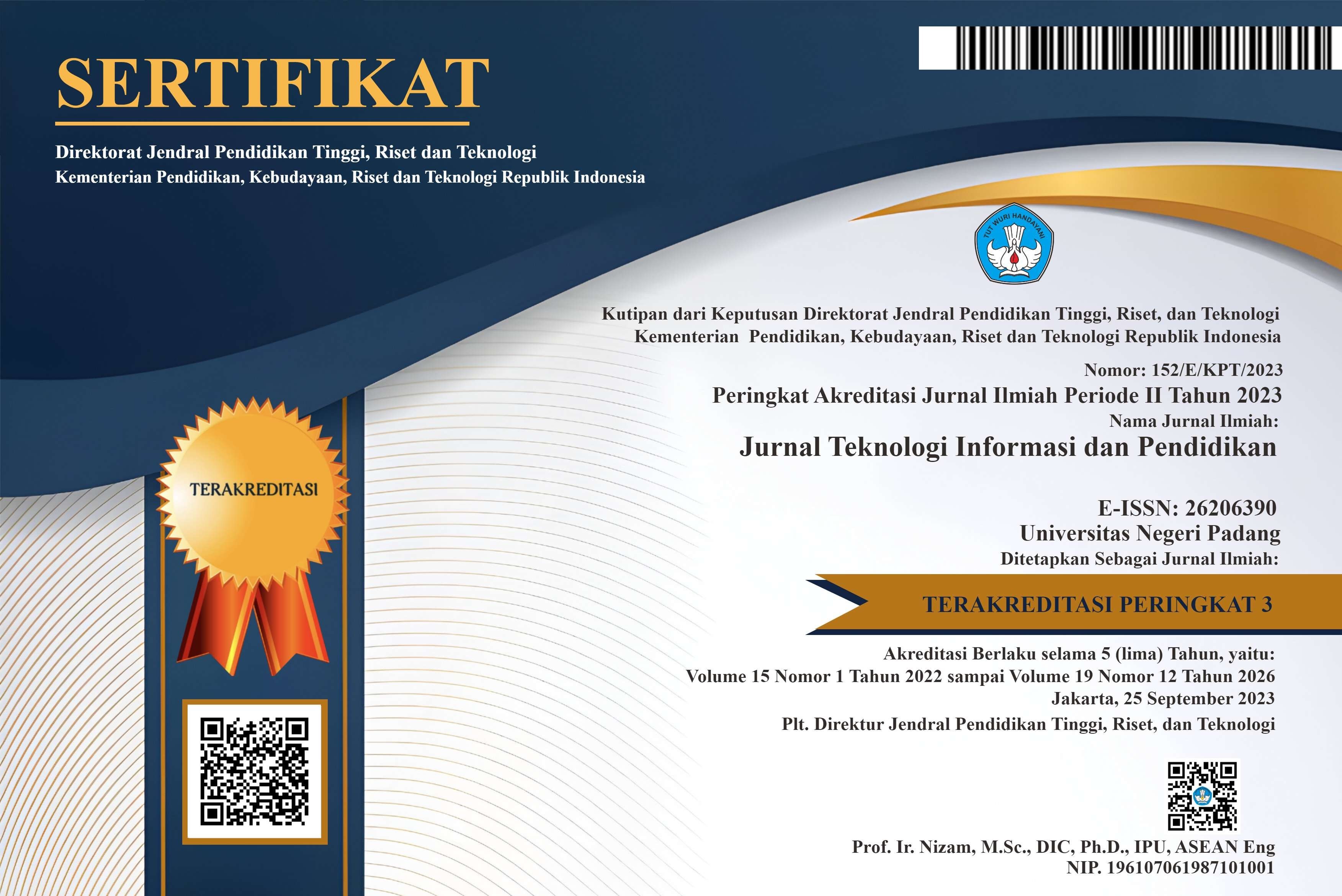The Speech Recognition Approaches for Emotion Regulation in Socially Assistive Robot
DOI:
https://doi.org/10.24036/jtip.v17i1.736Keywords:
Speech Recognition, Socially Assistive RobotAbstract
Socially Assistive Robot (SAR) can be created and used to assist children with special needs specifically those with autism, to manage their emotions through the therapy they need, which is then programmed into the robot. The therapy used on the robot is Applied Behavioral Analysis (ABA) therapy in the form of a guessing game with pictures. This therapy utilizes one of the methods in the robot's program, which is Speech Recognition, to provide feedback from the child using the robot. Speech recognition plays a role in facilitating the interaction between the child and the robot. When the picture-guessing game starts, the robot displays an image on the LCD screen and asks the child to guess the name of the object shown in the picture. At that moment, Speech Recognition works by recording the child's voice and converting it into text, then comparing the child's answer with the correct answer. When the child answers correctly, the robot provides praise, while if the child answers incorrectly, the robot encourages the child to try answering correctly again. This system allows the Socially Assistive Robot to support children with autism in managing their emotions by combining the ABA therapy method with the program's interactive feature enabled by Speech Recognition. Speech Recognition enhances communication and interaction between the child and the robot, creating a supportive and engaging therapeutic experience.
References
Kementerian Kesehatan Republik Indonesia, “Hari Peduli Autisme Sedunia: Pentingnya Pendampingan dan Edukasi bagi Anak Gangguan Spektrum Autisme ditengah Pandemi Covid-19,” 2020.
M. C. Lai, M. V. Lombardo, and S. Baron-Cohen, “Autism,” Lancet, vol. 383, no. 9920, pp. 896–910, 2014, doi: 10.1016/S0140-6736(13)61539-1.
S. Ithriyah, “Effectiveness of ABA Therapy for Children with Special Needs of Autism: A Study of Psycholinguistics View,” Ethical Ling. J. Lang. Teach. Lit., vol. 5, no. 2, pp. 149–158, 2018, doi: 10.30605/ethicallingua.v5i2.887.
R. K. Ross, “Beyond autism treatment: The application of applied behavior analysis in the treatment of emotional and psychological disorders.,” Int. J. Behav. Consult. Ther., vol. 3, no. 4, pp. 528–536, 2007, doi: 10.1037/h0100826.
J. Suteja and R. Wulandari, “Bentuk dan Model Terapi Terhadap Anak-Anak Penyandang Autisme (Keterbelakangan Mental),” Sci. Educ., vol. 2, no. April, pp. 113–124, 2013.
D. O. Johnson et al., “Socially Assistive Robots: A Comprehensive Approach to Extending Independent Living,” Int. J. Soc. Robot., vol. 6, no. 2, pp. 195–211, 2014, doi: 10.1007/s12369-013-0217-8.
C. Recchuto et al., “Cloud Services for Culture Aware Conversation: Socially Assistive Robots and Virtual Assistants,” 2020 17th Int. Conf. Ubiquitous Robot. UR 2020, pp. 270–277, 2020, doi: 10.1109/UR49135.2020.9144750.
Purba Bagus Sunarya, M. Irvan, and D. P. Dewi, “Kajian Penanganan Terhadap Anak Berkebutuhan Khusus,” J. Abadimas Adi Buana, vol. 2, no. 1, pp. 11–19, 2018, doi: 10.36456/abadimas.v2.i1.a1617.
A. Reichenbach et al., “Penerapan Terapi Applied Behavior Analysis (Aba) Dalam Mengatasi Emosi Negatif Anak Autis Di Sekolah Luar Biasa Negeri Parepare,” Prog. Retin. Eye Res., vol. 561, no. 3, pp. S2–S3, 2019.
A. Robaczewski, J. Bouchard, K. Bouchard, and S. Gaboury, Socially Assistive Robots: The Specific Case of the NAO, vol. 13, no. 4. Springer Netherlands, 2021. doi: 10.1007/s12369-020-00664-7.
M. J. Matarić and B. Scassellati, “Socially assistive robotics,” Springer Handb. Robot., no. April, pp. 1973–1993, 2016, doi: 10.1007/978-3-319-32552-1_73.
Kementerian Kesehatan Republik Indonesia, “Hari Peduli Autisme Sedunia: Pentingnya Pendampingan dan Edukasi bagi Anak Gangguan Spektrum Autisme ditengah Pandemi Covid-19,” 2020.
M. C. Lai, M. V. Lombardo, and S. Baron-Cohen, “Autism,” Lancet, vol. 383, no. 9920, pp. 896–910, 2014, doi: 10.1016/S0140-6736(13)61539-1.
S. Ithriyah, “Effectiveness of ABA Therapy for Children with Special Needs of Autism: A Study of Psycholinguistics View,” Ethical Ling. J. Lang. Teach. Lit., vol. 5, no. 2, pp. 149–158, 2018, doi: 10.30605/ethicallingua.v5i2.887.
R. K. Ross, “Beyond autism treatment: The application of applied behavior analysis in the treatment of emotional and psychological disorders.,” Int. J. Behav. Consult. Ther., vol. 3, no. 4, pp. 528–536, 2007, doi: 10.1037/h0100826.
J. Suteja and R. Wulandari, “Bentuk dan Model Terapi Terhadap Anak-Anak Penyandang Autisme (Keterbelakangan Mental),” Sci. Educ., vol. 2, no. April, pp. 113–124, 2013.
D. O. Johnson et al., “Socially Assistive Robots: A Comprehensive Approach to Extending Independent Living,” Int. J. Soc. Robot., vol. 6, no. 2, pp. 195–211, 2014, doi: 10.1007/s12369-013-0217-8.
C. Recchuto et al., “Cloud Services for Culture Aware Conversation: Socially Assistive Robots and Virtual Assistants,” 2020 17th Int. Conf. Ubiquitous Robot. UR 2020, pp. 270–277, 2020, doi: 10.1109/UR49135.2020.9144750.
Purba Bagus Sunarya, M. Irvan, and D. P. Dewi, “Kajian Penanganan Terhadap Anak Berkebutuhan Khusus,” J. Abadimas Adi Buana, vol. 2, no. 1, pp. 11–19, 2018, doi: 10.36456/abadimas.v2.i1.a1617.
A. Reichenbach et al., “Penerapan Terapi Applied Behavior Analysis (Aba) Dalam Mengatasi Emosi Negatif Anak Autis Di Sekolah Luar Biasa Negeri Parepare,” Prog. Retin. Eye Res., vol. 561, no. 3, pp. S2–S3, 2019.
A. Robaczewski, J. Bouchard, K. Bouchard, and S. Gaboury, Socially Assistive Robots: The Specific Case of the NAO, vol. 13, no. 4. Springer Netherlands, 2021. doi: 10.1007/s12369-020-00664-7.
M. J. Matarić and B. Scassellati, “Socially assistive robotics,” Springer Handb. Robot., no. April, pp. 1973–1993, 2016, doi: 10.1007/978-3-319-32552-1_73.















.png)














